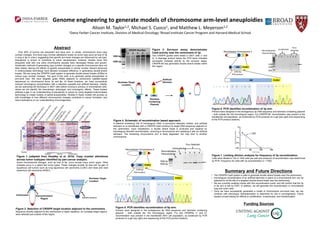
2014-11-17 Taylor Broad Poster FINAL
- 1. Genome engineering to generate models of chromosome arm-level aneuploidies Alison M. Taylor1,2, Michael S. Cuoco1, and Matthew L. Meyerson1,2 1Dana-Farber Cancer Institute, Division of Medical Oncology 2Broad Institute Cancer Program and Harvard Medical School Over 90% of tumors are aneuploid and have arm- or whole- chromosome level copy number changes. Arm-level copy number alterations cluster by tumor type (such as loss of 3p in lung or 8p in colon), suggesting that specific arm-level changes are influenced by cell type. Aneuploidy is known to contribute to tumor development; however, studies show that aneuploid cells with one extra chromosome actually have decreased fitness and growth. Systematic methods of generating copy number changes on a specific chromosome have not been tested, leaving the effects of specific aneuploidies in cancer unclear. Recent advances in endonuclease technology have allowed increased efficiency in generating double-strand breaks. We are using the CRISPR-Cas9 system to generate double-strand breaks (DSBs) to induce copy number changes. The goal of this work is to generate partial aneuploidies of arm-level loss. We have targeted guide RNAs adjacent to centromeric satellite-repeat sequences on chromosome arms 3p and 8p. At these locations, we have successfully induced homologous recombination with a selection cassette and artificial telomere. Initially, we are optimizing the technique in 293T cells before moving to primary or immortalized cells, where we will identify the downstream phenotypic and tumorigenic effects. These studies address a gap in our understanding of aneuploidy in cancer by using targeted endonuclease technology to create models of partial aneuploidies. Studies in these models will provide us with knowledge of how different chromosomal changes contribute to cancer formation, and have implications on our understanding of tumorigenesis. Abstract Figure 2. Selection of CRISPR target location adjacent to the centromere. Sequence directly adjacent to the centromere is highly repetitive, so nuclease target regions were selected just outside of this region. Nuclease Target Location Centromere Pericentromeric Region Repetitive Sequence CRISPR Number 1 2 1 2 --- Figure 3. Surveyor assay demonstrates Cas9 activity near the centromere of 3p. Two CRISPR guides were tested in 293T cells (1 and 2). A cleavage product below the PCR band indicates successful nuclease activity by the surveyor assay. CRISPR #2 has generated double strand breaks within this region. Nuclease Target Location X HR PURO HR PURO Telomere Containing Plasmid Artificial Telomere + Figure 4. Schematic of recombination based approach. A plasmid containing 1kb of homologous DNA, a puromycin selection marker, and artificial telomere is co-transfected with a CRISPR-Cas9 construct to target DNA sequence adjacent to the centromere. Upon transfection, a double strand break is produced and repaired by homologous directed recombination, removing a chromosome arm replacing it with an artificial telomere. The remaining chromosome arm is likely degraded, but may bind to another chromosome. Unselected Puro Selected 1 2 -- 1 1 2 2 Recombination Plasmid Alone 1500 1000 500 • The CRISPR-Cas9 system is able to generate double strand breaks near the centromere. • Homologous recombination of an artificial telomere in place of a chromosome arm can be selected for at the site of a targeted double strand break near the centromere. • We are currently isolating clones with this recombination event, and will confirm that the 3p or 8p arm is lost by FISH. In addition, we will generate the recombination in immortalized lung and colon cells. • Once we have successfully generated a model of chromosome arm-level loss, we can continue with phenotypic characterization to determine its role in tumorigenesis. Future studies include testing for effects on proliferation, invasiveness, and transformation Summary and Future Directions Funding Sources Figure 1 (adapted from Hoadley et al, 2014). Copy number alterations across tumor subtypes identified by pan-cancer analysis. Some chromosomal changes, such as loss of 8p, occur across many tumor types. Other changes occur in a select few tumor types. These changes include 3p loss and 3q gain in squamous cell tumors such as lung squamous cell carcinoma (LUSC) and head and neck squamous cell carcinoma (HNSC). Figure 6. PCR identifies recombination of 3p arm. Primers were designed in the endogenous 3p DNA sequence and telomere containing plasmid – both outside the 1kb homologous region. For CRISPR #2, recombination was present in the transfected cell population, as evidenced by PCR products on a gel (top right) and sequencing of the PCR product (bottom). Figure 7. Limiting dilution analysis for frequency of 3p recombination. Cells were diluted to 100 or 1000 cells per well and presence of recombination was determined by PCR. Frequency for cells with 3p recombination is ~1/300. 1650 bp 1000 bp Figure 5. PCR identifies recombination of 8p arm. Primers were designed in the endogenous 8p DNA sequence and telomere containing plasmid – both outside the 1kb homologous region. For two CRISPRs (1 and 2), recombination was present in the transfected 293T cell population, as evidenced by PCR products on a gel (top right) and sequencing of the PCR product (bottom). Untransfected Puro Selected 1 1 2 2 Recombination Plasmid Alone PUROHR HR PURO 1100 bp PCR product Recombined Chromosome 8 PUROHR HR PURO 1300 bp PCR product Recombined Chromosome 3 1:300 1500 bp 1000 bp